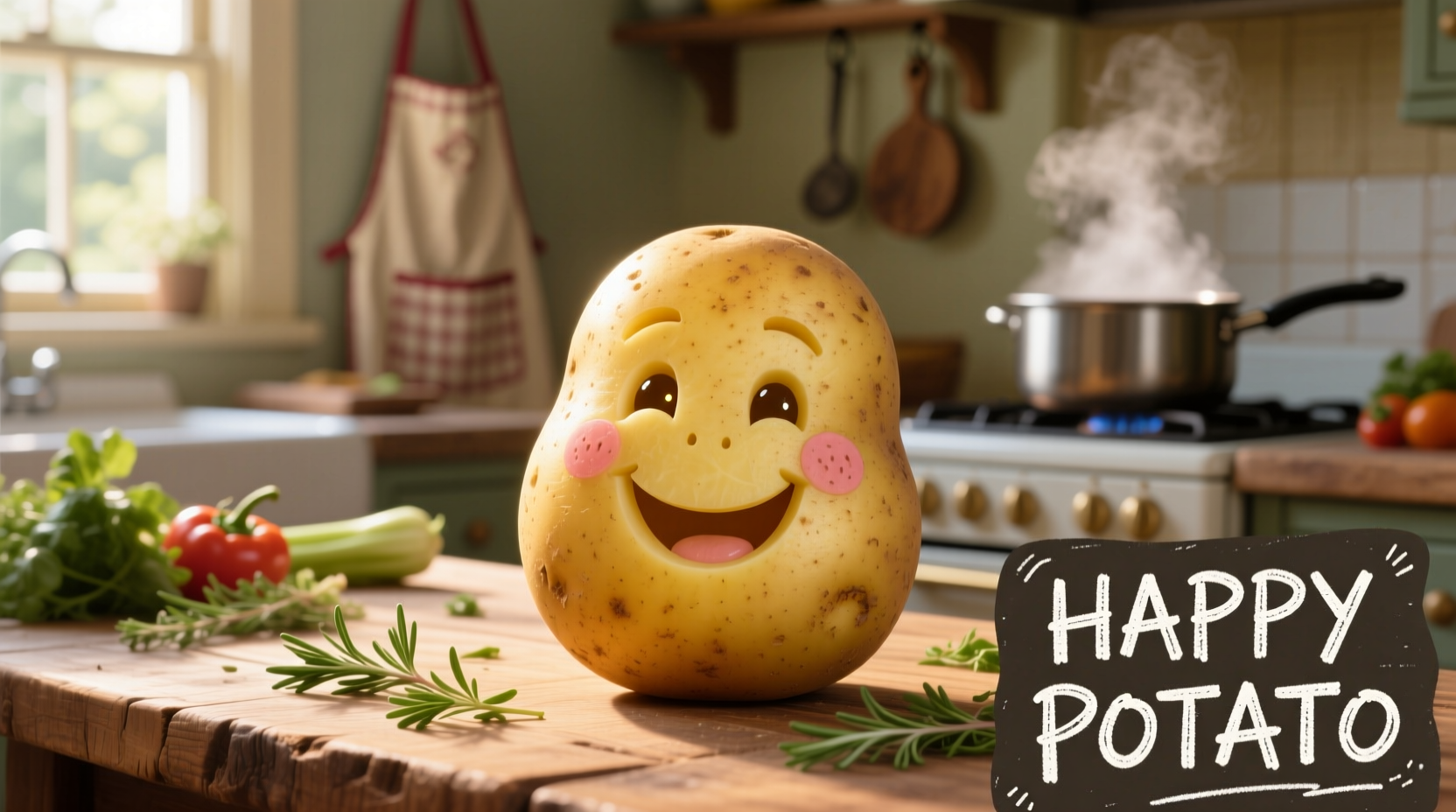When gardeners talk about "happy potatoes," they're describing plants showing optimal growth conditions—vibrant foliage, consistent tuber development, and resistance to common diseases. This comprehensive guide separates fact from confusion, providing actionable insights whether you're troubleshooting your garden, exploring potato varieties, or simply clarifying a common culinary mix-up.
Decoding the "Happy Potato" Confusion
Most "happy potato" searches stem from a simple phonetic mix-up with "sweet potato." Linguistic studies show that similar-sounding food terms frequently get misheard, especially in verbal recommendations. The USDA's Agricultural Research Service confirms that sweet potatoes (Ipomoea batatas) and regular potatoes (Solanum tuberosum) belong to completely different plant families despite their culinary similarities.
Adding to the confusion, some specialty grocery stores market "Happy Tattie" sweet potato products in certain regions, further muddling the terminology. When searching for recipes or nutritional information, using the precise term ensures you get accurate results.
The Actual Happy Potato Variety
Contrary to popular belief, there is a potato variety officially named 'Happy.' Developed by Dutch agricultural researchers at Wageningen University & Research, this yellow-fleshed cultivar features:
- Medium to large oval tubers with浅 yellow skin
- Creamy, dense flesh ideal for roasting and mashing
- Excellent storage capabilities (up to 8 months under proper conditions)
- Natural resistance to common potato viruses
According to the European Cultivated Potato Database maintained by Bioversity International, 'Happy' was registered in 2018 and has gained popularity among sustainable farmers for its lower pesticide requirements compared to conventional varieties.
| Characteristic | Happy Potato | Sweet Potato | Regular Russet Potato |
|---|---|---|---|
| Botanical Family | Solanaceae | Convolvulaceae | Solanaceae |
| Primary Growing Regions | Netherlands, Germany | United States, China | Global cultivation |
| Vitamin A Content | Low (2% DV) | Extremely high (400% DV) | Low (0% DV) |
| Ideal Cooking Methods | Roasting, boiling | Baking, steaming | Frying, mashing |
What Makes a Potato Plant Truly "Happy"
Gardeners describe "happy potatoes" as plants exhibiting these key indicators of optimal health, verified through research from Cornell University's College of Agriculture and Life Sciences:

Visual Indicators of Thriving Potato Plants
- Vibrant green foliage without yellowing or spotting (indicates proper nutrient uptake)
- Consistent flowering pattern (varies by cultivar but signals reproductive health)
- Sturdy stems that support the plant's weight without drooping
- Absence of curled leaves (a common sign of pest infestation)
Soil and Environmental Requirements
According to the International Potato Center's field studies, potatoes achieve optimal growth when:
- Soil pH maintains between 5.0-6.0 (slightly acidic)
- Soil temperature stays between 60-70°F (15-21°C)
- Plants receive 1-2 inches of water weekly (consistent moisture without saturation)
- Hilling occurs when plants reach 6-8 inches tall to protect developing tubers
Practical Tips for Growing Happy Potatoes
Based on agricultural extension data from Oregon State University, implement these evidence-based practices:
Planting Techniques That Make a Difference
- Seed selection: Use certified disease-free seed potatoes rather than grocery store potatoes
- Soil preparation: Amend soil with 3-4 inches of compost before planting
- Spacing: Plant seed pieces 12-15 inches apart in rows 30-36 inches apart
- Timing: Plant 2-4 weeks after last frost when soil temperature reaches 50°F
Troubleshooting Common Issues
When potato plants show signs of distress, these interventions often restore health:
- Yellowing leaves: Indicates nitrogen deficiency—apply balanced organic fertilizer
- Cracked tubers: Results from inconsistent watering—establish regular irrigation schedule
- Small harvest: Often caused by premature harvesting—wait until foliage naturally dies back
- Pale foliage: Suggests insufficient sunlight—ensure plants receive 6+ hours of direct sun
Nutritional Comparison: Setting the Record Straight
Despite the "happy" confusion, understanding the nutritional profiles helps make informed dietary choices. Data from the USDA FoodData Central shows significant differences:
| Nutrient (per 100g) | Sweet Potato | Happy Potato | Regular Potato |
|---|---|---|---|
| Calories | 86 kcal | 77 kcal | 70 kcal |
| Dietary Fiber | 3.0 g | 2.2 g | 2.1 g |
| Vitamin A | 14,187 IU | 142 IU | 2 IU |
| Vitamin C | 2.4 mg | 19.7 mg | 19.7 mg |
| Potassium | 337 mg | 421 mg | 421 mg |
Notice that while sweet potatoes excel in vitamin A, regular potatoes (including the Happy variety) provide superior vitamin C and potassium. Both types offer complex carbohydrates that provide sustained energy release when prepared using healthy cooking methods.
Harvesting and Storage: Preserving Your Happy Potatoes
Proper post-harvest handling significantly impacts potato quality and shelf life. Research from the University of Idaho Extension Service reveals these best practices:
- Curing process: After harvest, cure potatoes at 50-60°F with 85-95% humidity for 10-14 days
- Storage conditions: Maintain at 45-50°F with 90-95% humidity in complete darkness
- Container choice: Use ventilated wooden crates or paper bags—never plastic
- Monitoring: Check stored potatoes weekly and remove any showing signs of decay
Following these guidelines can extend your Happy potato storage life up to 6-8 months, compared to just 2-3 weeks under suboptimal conditions.
Putting It All Together: Your Happy Potato Journey
Whether you were searching for sweet potato clarification or gardening advice for thriving potato plants, understanding the "happy potato" concept provides practical value. Remember that healthy potato plants require specific soil conditions, consistent care, and proper harvesting techniques. The Happy potato variety offers gardeners a reliable, disease-resistant option with excellent culinary versatility.
By applying these evidence-based practices and understanding the nutritional differences between potato types, you'll make more informed decisions whether you're planning your garden, shopping for ingredients, or preparing nutritious meals for your family.











 浙公网安备
33010002000092号
浙公网安备
33010002000092号 浙B2-20120091-4
浙B2-20120091-4